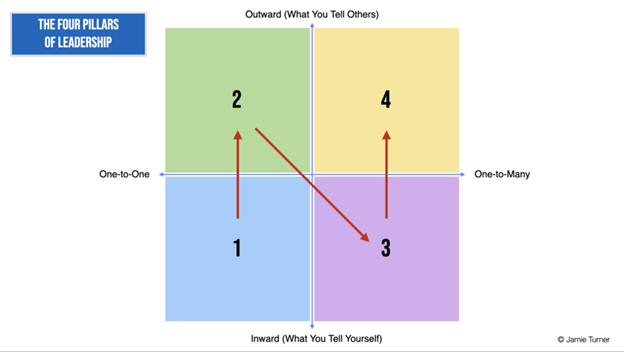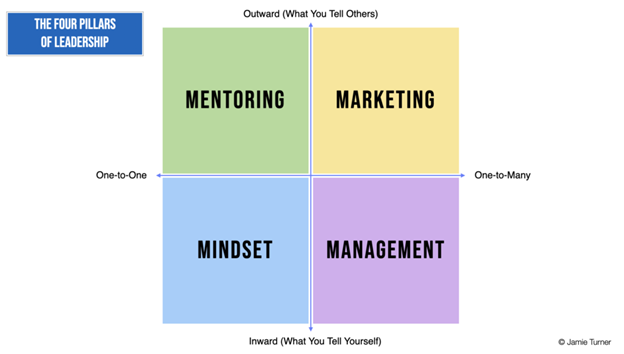What Science Teaches Us About Being a Good Leader
By Jamie Turner
What does it take to be a good leader? How do business leaders inspire those around them? And what leadership styles can you adopt for your own needs?
If you’re a manager, mentor, or business executive looking for answers to those questions, keep reading. My name is Jamie Turner. I’m an author, university professor, and management consultant who speaks around the globe about effective leadership.
But before we dive into how you can be a better leader, let’s kick off with a definition of leadership. After all, we can’t dig into leadership styles before we define what it means to be a leader.
There are thousands of definitions of leadership, many of which are convoluted and hard to understand. When it comes to definitions, the best ones are simple, clear, and surprisingly profound.
So, with that in mind, I’d like to point you to David Rubenstein’s definition which can be found in his excellent book, How to Lead.
“A leader is someone who makes something happen that wouldn’t have happened otherwise.”
Eisenhower was a great leader. Steve Jobs was a great leader. Sheryl Sandberg is a great leader. As are Oprah Winfrey, Jeff Bezos, Indra Nooyi, and Elon Musk.
Why? Because they’re all people who made something happen that wouldn’t have happened otherwise.
A Roadmap for Effective Leadership
Which kind of leader do you want to be? Hopefully, you want to be a leader who is both effective and well-liked by the people you’re leading. (Studies show that leaders who are well-liked and admired are more effective than those who are not well-liked or admired.)
With that in mind, let’s take a look at the Four Pillars of Leadership, which is a 2×2 framework I’ve developed based on decades of experience and which I share in workshops and consulting assignments around the globe.
The purpose of the Four Pillars is to help you wrap your mind around the techniques you’ll be using to become a better leader.
On the X-axis, you’ll see techniques that are deployed either one-to-one (on the left) or one-to-many (on the right). In other words, these techniques are executed from you to one person or from you to many people.
On the Y-axis, you’ll see techniques that are defined as Inward (What You Tell Yourself) and Outward (What You Tell Others).
If that’s a little confusing, don’t worry because it’ll make more sense in a second.
When you put the two axes together, it looks like the 2×2 framework below, with four separate quadrants.

Quadrant one is made up of techniques you tell yourself in a one-to-one capacity. These techniques are based on the idea that all great leaders work on their mindset first and their skillset second. So, quadrant one is about mindset.
Quadrant two is made up of techniques you tell others in a one-to-one capacity. These techniques are ones that you’ll use when you’re mentoring an employee. So, quadrant two is about mentoring.
Quadrant three is made up of techniques you tell yourself in a one-to-many scenario. Let’s say you’re managing a small team — these are the kinds of things you would tell yourself so that you could be a better manager, mentor, or team leader. So, quadrant three is about management.
Quadrant four is made up of techniques you tell others in a one-to-many scenario. These are techniques you would use when communicating to large groups of employees or to large groups of customers. So, quadrant four is about marketing.
Here’s what the Four Pillars of Leadership looks like when you add mindset, mentoring, management, and marketing to the framework.

Let’s unpack some of the techniques you can use based on the Four Pillars shown above. By putting these techniques into practice, you’ll develop your own unique style of leadership, which will help you be an authentic, genuine, and more effective leader. (We’ll dig a little deeper into these in the upcoming workshop.)
Mindset
All great leaders understand that it takes a certain mindset to be an effective leader. With that in mind, here are some of the techniques from quadrant one that you can use to work on your mindset.
-
- Choose to act rather than react. Many executives wait for stimuli before acting. In other words, they wait for something to happen to them and then play defense by reacting to whatever happened. Successful leaders play offense. In other words, they make something happen rather than waiting for something to happen to them.
- Understand that failure is not an ending, it’s a beginning. We learn more from our failures than we do from our successes. So, remember, every failure in life teaches you things you can apply later in your life. As Friedrich Nietzsche said, “That which does not destroy us makes us stronger.”
- Recognize that confidence is the product of action. Many people believe that confident leaders are either born confident or are told so many wonderful things about themselves that they magically feel confident. The truth is that confidence happens when you’ve acted on something and seen it come to fruition. So, remember, confidence isn’t about saying wonderful things about yourself, it’s about taking action and seeing positive results.
Mentorship
If you’re interested in leadership, the odds are you’ve been asked to lead a team, an organization, or an entire company. With that in mind, one of your most important skillsets will be to mentor those around you. And the secret to mentorship comes down to one thing – empathy.
Let’s look at the techniques you can use to become a more effective mentor.
-
- Recognize that all humans are motivated by self-interest. There’s one thing all humans have in common — we’re usually motivated by what benefits us, not necessarily by what benefits others. (There are some exceptions, of course.) With that in mind, it’s important to understand that any mentoring you do has to be motivated by the recipient’s self-interest. In other words, what’s in it for them? How can you make your goals (or your organization’s goals) match what they want in life?
- When mentoring, start with what, not why. When you start with “Why did you do that?” it sounds accusatory. When you start with “What were your plans when you took that action?” it’s less accusatory. That small change can build a bridge between you and the person you’re mentoring.
- Err on the side of Grace. As a mentor, you’ll have plenty of opportunities to correct the behavior of your mentee. When those times arise, err on the side of Grace rather than the law. In other words, be kind and generous in your feedback, rather than dictatorial and abrasive. Of course, there will be exceptions to this, but to build a long-term relationship with your mentee, it’s better to start from a place of Grace rather than the law.
Management
Management is about getting teams of employees to follow your suggestions and your recommendations. With that in mind, let’s look at how good communication skills can help you become a better leader.
-
- 80% of business problems can be solved through better communication. It’s hard to believe, but most problems in business revolve around misunderstandings, vague instructions, and a lack of clear dialogue. In my consulting practice and my workshops, we spend a great deal of time working out ways to improve communication.
- People want to be told which mountain to climb, not how to climb it. The quickest way to de-motivate a team is to micro-manage them. Instead, let them know which mountain they should climb and then support them if (and only if) they need help.
- Successful meetings start with successful endings. It’s always surprising to see how many meetings end with no clear call-to-action. Many times, people simply wrap up meetings with no summary or next steps. You can double the effectiveness of your meetings by re-capping the key insights and assigning action items to the attendees.
Marketing
Whether you’re communicating with your staff or with your customers, it all comes down to marketing. In other words, it comes down to packaging your message so that it resonates with your audience on an emotional level.
Let’s look at how you can become a better marketer, whether you’re talking to your staff or talking to your customers.
-
- The best messages are simple and easy to understand. In my work with The Coca-Cola Company, Holiday Inn, and other global brands, one of the key things I try to do is to simplify their messaging. Why is this so important? Because for a message to stick, it must be something that resonates emotionally and that they can remember at a moment’s notice.
- Your audience is inundated with other messages. Your audience is flooded with thousands of pieces of communication each day. As a result, they can get confused and conflicted. So, keep things simple and easy to understand.
- Follow the rule of threes. For reasons that aren’t entirely clear, the human brain thinks in groups of three. It’s almost as if the brain is pre-programmed that way. So, try to break concepts down into groups of three. If you find yourself needing to communicate more than three key points, it’s better to break them down rather than trying to force your audience to remember all 6 or 7 or whatever the number is. In other words, share two groups of three concepts rather than six concepts all at once.